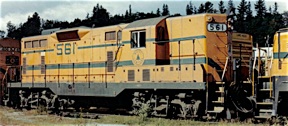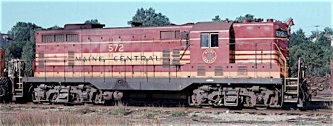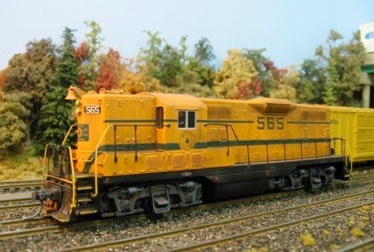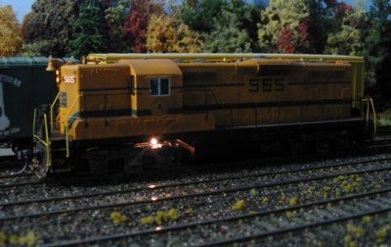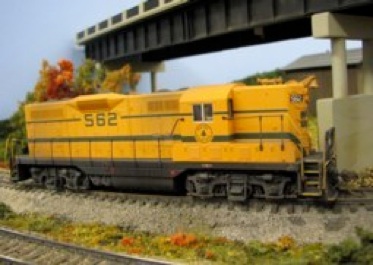The Northeast kingdom railroad

Maine Central GP7 Locomotives
Web page written and maintained by Mike McNamara
Last Update: June 6, 2008

The The Maine Central rostered a nice fleet of 24 EMD GP7s that lasted into the Guilford era. Originally these were delivered in the classic maroon and gold scheme similar to the Boston & Maine. Later, units were delivered and others repainted into a green and gold scheme. After the GP38's ushered in the harvest gold with pine green lettering era, the MEC started repainting the GP7s into the same scheme, standardizing the look of the locomotive roster. This scheme was later modified slightly when units were overhauled in the late 1970's. (the main difference being the round herald on the ends instead of the rectangular herald). Some units even went back to the classic maroon and gold prior to the Guilford takeover.
Some units were dynamic brake equipped (561-569) and some were not (571-581), some had steam generators and others did not. Four units (590-593) were acquired second-hand from the L & N in 1978. Various changes were made through the years, including horn placement, bell location, ditch lights, roof paint and chopped noses, so having a picture of the unit at the time you want to model it is essential if you want to be accurate. Of course you can pick and choose what you like and leave it at that!
GP7 #581 shows the original Maroon & Gold colors, the same used on Boston & Maine locomotives in the 1950s.
In time the MEC received GP7s in a similar scheme, substituting green for the maroon. Only 566-569 were delivered in this scheme. Here is a P2K GP7 at work on my previous layout.
GP7 #567 shows the GP38-inspired Harvest Gold and Pine Green scheme that was the standard for the 1970s.



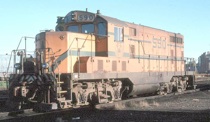

GP7 #573 received a number of different, unique schemes through the years. Here is one from the late-70s when the train was used in special passenger service.
GP7 #578 shows the results of MEC’s chop-nose program where a number of units received a new front end affording better visibility.
Conway Scenic acquired a Guilford GP7 and repainted it back to it’s original scheme and original number, 573. The Geep plies familiar rails, powering tourist trains to Bartlett and Crawford Notch in New Hampshire.

GP7 #590 is one of the Geeps acquired secondhand from the Louisville & Nashville.
After the Guilford takeover of the MEC, the GP7s started getting repainted into standard Guilford gray. Most were lettered for Springfield Terminal. This unit is ex-MEC 592.

Maine Central GP7 # 565
In 2004, Atlas released their HO GP7 in the Maine Central's Harvest Gold and Green scheme. These locomotive in their Classic series features some finer details and nicer handrails than previous releases. The model is nicely painted and runs well, but it does not have any specific details for a MEC GP7. In fact some items, such as the horns, are wrong. So I decided to to take my stock unit numbered 565 and see what I could do to make it more accurate for MEC circa 1980.
The unit comes painted in the earlier scheme with the rectangular herald on the noses, so I decided to match details appropriate to that scheme. I found numerous photos in the Maine Central In Color books that helped me decide what should be removed and what should be added.
Starting with removal, I carefully pulled out the horns on each side. I trimmed the tabs off of these and stuck them back in the mounting holes and touched a little glue from the inside. I touched these with some Polly Scale MEC Harvest Gold paint to hide them a bit. It's not an exact match, but with some weathering these aren't to noticeable. I also used sharp flush cutting sprue cutters to remove the MU detail from each end handrail.
My MEC GP7 Models
I added Detail Associates tall early MU Stands (#1502) to each end. I drilled a hole and mounted a 3 chime airhorn, using the one Atlas supplies with their GP38s (as I will be replacing those with 5 chimes). I mounted a Custom Finishing #110 MEC Bell on the front hood. I think these are a little oversized, but they are the only part I know available for this style bell. I added a piece of black wire to represent the control cable.
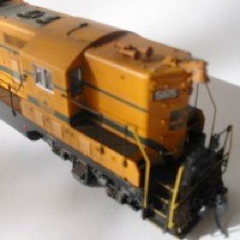
Pictures show a wire on the cab roof leading to a radio antenna. I modeled this with some wire with the insulation removed and painted black. I drilled a hole into the small cab face area below the roof for where the wire enters the cab and put one end into the hole. I matched the bends of the wire to the photo leading to the center of the cab roof. For the antenna, I used a small piece of plastic strip also painted black.
The MEC used winterization hatches on just about all of their early Geeps. These can be modeled using Detail Associate (#2013) or Details West (#164) parts. (Note: This is not installed yet in the photos as I had to order this part at the hobby shop).
I used a Digitrax DH163IP plug in decoder on this unit. I wanted to install ditch lights on this unit to take advantage of the decoder's ditch light feature. But in research, GP7s in the earlier Harvest Gold scheme did not have ditch lights. These appear to be added after shopping and repainting into the next scheme with the round end herald.
In looking at the prototype photos, there were some night shots that showed lighting above the front trucks under the cab area. I decided to add this for fun. I used Miniatronics 1.5v bulbs and a resistor on each bulb and soldered them to the F3 function on the decoder. It makes for a neat look when they are turned on.
I finished up the model with some painting and weathering. I touched the class lights on each end with Tamiya Smokey Clear Gloss paint which does a good job of looking like glass. I used Polly Scale aluminum to touch the ends of each MU hose. I used Bragdon chalks for weathering, putting black, rust and grimy black on all surfaces. I also used their dust on the trucks and pilots. Finally, I replaced the couplers with Kadee #58 couplers and the locomotive was ready for service.
Maine Central GP7 idles in the St. Johnsbury yard after returning with local TY-X local from North Stratford, NH. As the daylight fades, the truck lighting on the unit shows. (Click on image for larger view)
(Click on image for larger view)
Maine Central GP7 # 562
Another Atlas 2004 release, MEC GP7 #562 received many of the details described for #565. But this unit also received a Soundtraxx DSD Sound decoder. It is a drop in board that provides power and sound for 1st generation EMD locomotives. Installation was very easy and the mini oval speaker with enclosure fits easily in the short hood above the truck and weight.
(Click on image for larger view)
GP7 #571 is wearing a simplified green scheme that started appearing in the 1970s. It was applied to only 4 units: 564, 566, 569 and 571.

(Click on image for larger view)
Maine Central GP7 # 564
I had acquired an undecorated Atlas GP7 with dynamic brakes a while back and it sat without me having a specific plan for it. In looking at photos, I noticed that #564 shows up often in St. Johnsbury and on the Mountain Subdivision. In particular there is a shot of the Geep leading a ballast extra. I also found a photo in the MEC In Color 2 book that shows the unit in the MEC simplified green scheme in 1981 prior to getting a chopped nose and becoming #470. I figured this was the perfect use for my undec GP7, #564 in the simplified green scheme, circa 1980.
MEC 564 Photo coming soon!
>> Back To Locomotives main page
>> Back To Maine Central main page
Maine Central GP7 # 566
Proto 2000 unit in the early green scheme.

A good look at the front of a unit in the early scheme. The bell, drop step and MU stands are visible here, along with the steam generator stack (to the right of the bell).


